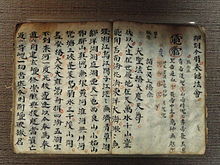- Sawndip
-
Sawndip
Old Zhuang script
Characters for the Zhuang words saw "character" and ndip "uncooked"Type Logographic Languages Zhuang Time period to present Parent systems Chinese- Sawndip
Zhuang characters or Sawndip are logograms derived from Han characters and used by the Zhuang people of Guangxi, China to write the Zhuang language. In Mandarin Chinese, these are called Gǔ Zhuàngzì (Chinese: 古壮字; literally "old Zhuang characters") or Fāngkuài Zhuàngzì (方块壮字; "square shaped Zhuang characters").
Contents
History
Sawndip (Sawndip:
 [1]) is a Zhuang word that means "immature character". The Zhuang word for Hanzi used in the Chinese language is "sawgun"(Sawndip:
[1]) is a Zhuang word that means "immature character". The Zhuang word for Hanzi used in the Chinese language is "sawgun"(Sawndip:  倱[1]; lit. "original writing system") (saw meaning character or book, and gun meaning the Han Chinese ethnicity, cognate to 漢), whilst "sawndip" refers to the characters used exclusively in the Zhuang language. Though it is not clear when they were created, the oldest known record of these logograms is a stele built in 689, during the Tang dynasty.[citation needed] These logograms were used earlier than the Vietnamese Chữ Nôm.[2]
倱[1]; lit. "original writing system") (saw meaning character or book, and gun meaning the Han Chinese ethnicity, cognate to 漢), whilst "sawndip" refers to the characters used exclusively in the Zhuang language. Though it is not clear when they were created, the oldest known record of these logograms is a stele built in 689, during the Tang dynasty.[citation needed] These logograms were used earlier than the Vietnamese Chữ Nôm.[2]They have been used for over 1300 years by Zhuang singers and shamans to record poems and scriptures. Though the romanized script for the Zhuang language was created in 1957 as the official script, Sawndip continues to be used to this day. Since the Tang Dynasty to this modern day, sawndip has been used to write texts such as poems, scriptures, folktales, myths, songs, play scripts, medical prescriptions, family genealogies and contracts; during the Cultural Revolution even communist revolutionary propaganda has been written using sawndip.[3]
Following the promotion of romanized Zhuang scripts, literacy amongst Zhuang speakers has increased, however there are major phonetic and lexical differences between Zhuang dialects, and the Latin-based system is based on the Wuming dialect; as a result, there still are Zhuang speakers that prefer to write Zhuang using sawndip.[3]
After five years of preparation, the Sawndip Sawdenj (Sawndip Dictionary; Chinese: 古壮字字典; pinyin: Gǔ Zhuàngzì Zìdiàn, Dictionary of Ancient Zhuang Characters) was published in 1989 with over 10,000 characters, and is the first and only dictionary of Zhuang characters published to date. In 2008 it was announced that work was to begin on a new dictionary called "The Large Chinese Dictionary of Ancient Zhuang Characters", 《中华古壮字大字典》.[4]
Characteristics
 These three Zhuang logograms from the Sawndip Sawdenj (the first two of which are presently not supported in Unicode) are formed as follows: the components 力,六 and 必 respectively indicate the sound, and the components 子,鳥 and 鳥 indicate the meaning. "Lwg roegbit", literally "child bird-duck", means "wild duckling".
These three Zhuang logograms from the Sawndip Sawdenj (the first two of which are presently not supported in Unicode) are formed as follows: the components 力,六 and 必 respectively indicate the sound, and the components 子,鳥 and 鳥 indicate the meaning. "Lwg roegbit", literally "child bird-duck", means "wild duckling".
According to Zhāng Yuánshēng (张元生), non-Chinese characters usually make up about 20% of Sawndip texts, although some texts may be composed almost entirely of Chinese characters[5]. Some of these logograms are used in the Chinese names for places in Guangxi, such as 岜 bya meaning mountain or 崬 ndoeng meaning forest, and are therefore included in Chinese dictionaries, and hence also in Chinese character sets.
So far the only Zhuang square characters encoded in Unicode are ideograms that are also present in non-Zhuang character sets, which means that thousands of common Zhuang characters have yet to be encoded.
Sawndip is made up of a combination of Chinese characters, Chinese-like characters, and other symbols. Sawndip consists of a large number of allographs, with some morphosyllables having more than a dozen associated variant glyphs.[3]
Sawndip characters can be categorized using a more complex system than the six traditional classification principles:[3]
- Symbols that do not resemble Chinese characters, and are borrowed from non-Chinese writing systems such as the Latin alphabet[6] and (possibly) Burmese
- Non-standard Chinese-like characters created via Ideogrammatic compounds
- Non-standard Chinese-like characters created via Phono-semantic compounds
- Standard Chinese characters borrowed solely for their pronunciations, and do not share the same original meaning in Chinese (in accordance with the phonetic loan principle)
- Non-standard Chinese-like characters created specifically for Zhuang to indicate the meaning of certain morphosyllables (in accordance with Indicative ideograms)
- Standard Chinese characters representing loanwords or etymologically-related morphosyllables from Chinese
- Standard Chinese characters borrowed solely for their meanings and do not have a matching reading in Zhuang with Chinese
- Glyphs that are made of two Chinese characters combining to form one character, with each "spelling out" the pronunciation of the character, where one part may represent an initial consonant and the other the rime.
Example text
From Article 1 of the Universal Declaration of Human Rights:

- Latin transcription (1982 orthography): "Boux boux ma daengz lajmbwn couh miz cwyouz, cinhyenz caeuq genzli bouxboux bingzdaengj. Gyoengq vunz miz lijsing caeuq liengzsim, wngdang daih gyoengq de lumj beixnuengx ityiengh."
- Latin transcription (1957 orthography): "Bouч bouч ma dəŋƨ laзƃɯn couƅ miƨ cɯyouƨ, cinƅyenƨ cəuƽ genƨli bouчbouч biŋƨdəŋз. Gyɵŋƽ vunƨ miƨ liзsiŋ cəuƽ lieŋƨsim, ɯŋdaŋ daiƅ gyɵngƽ de lumз beiчnueŋч ityieŋƅ."
See also
References
- ^ a b Note: The character for "saw", ⿰書史, is supposed to be one character, with a 書 radical on the left, and 史 radical on the right. Similarly, "ndip" (⿰立生) is one character, made up of 立 and 生 radicals. As of present, there are limitations in displaying Zhuang logograms in Unicode, as they are unsupported. Sawndip characters have not been standardised, different writers use different characters for the same word, the examples here are from "Sawndip Sawdenj"
- ^ 2007-02-05, 壮族的语言文字, 来宾新闻
- ^ a b c d Prof. Robert S. Bauer, Written Representation of Zhuang and Cantonese, Department of Chinese and Bilingual Studies, Hong Kong Polytechnic University
- ^ http://www.gxmw.gov.cn/ArticleShow.aspx?id=797
- ^ Zhāng Yuánshēng 张元生: Zhuàngzú rénmín de wénhuà yíchǎn – fāngkuài Zhuàngzì 壮族人民的文化遗产——方块壮字. In: Zhōngguó mínzú gǔ wénzì yánjiū 中国民族古文字研究 (Beijing, Zhōngguó shèhuì kēxué chūbǎnshè 中国社会科学出版社 1984) page 456
- ^ Noted in page 43 of 《右江流域方块壮字文献的用字研究》 thesis by 韦玉防 2010 http://www.docin.com/p-138822822.html. Example, "k" is used on page 1031 of 平果嘹歌:长歌集 published by 广西民族出版社 in 2004, ISBN 7536348207.
Further reading
- Liáng Tíngwàng 梁庭望 (ed.): Gǔ Zhuàngzì wénxiàn xuǎnzhù 古壮字文献选注 (Tiānjīn gǔjí chūbǎnshè 天津古籍出版社 1992).
- Lín Yì 林亦: Tán lìyòng gǔ Zhuàngzì yánjiū Guǎngxī Yuèyǔ fāngyán 谈利用古壮字研究广西粤语方言. In: Mínzú yǔwén 民族语文 2004.3:16–26.
- Gǔ Zhuàngzì zìdiǎn 古壮字字典 Sawndip Sawdenj (Nanning, Guǎngxī mínzú chūbǎnshè 广西民族出版社 1989). ISBN ISBN 7536306148 / 9787536306141. Dictionary of Old Zhuang characters; contains 4,900 entries and more than 10,000 characters.
- Holm, David (2008). "The Old Zhuang script", in Diller, Anthony (ed.) The Tai-Kadai languages, Routledge, ISBN 978-0-7007-1457-5, pp. 415–428.
- Bauer, Robert S. (2000). "The Chinese-based writing system of the Zhuang language". Cahiers de linguistique – Asie orientale 29 (2): 223–253. doi:10.3406/clao.2000.1573.
External links
- Asian Character Tables, Free (GPL) Sawndip data.
- Chinese minority's character database -- Zhuang logogram information and image
- Zhuang language & alphabet, Omniglot
Categories:- Logographic writing systems
- Graphemes
- Chinese characters
Wikimedia Foundation. 2010.

